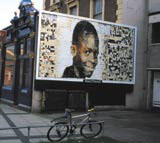Make some noise
CutUp sabotages billboards to transmit its thought-provoking messages, but is a mainstream design group the most appropriate place to exhibit the work?

CutUp’s most recent reordering, which went up last week in Shoreditch, shows a screaming woman created by a patchwork of posters superimposed on a billboard. ‘J’ explains her face is meant to show our damaged psyche, capable now only of expressing emotions that are pre-formulated in the media. He refers to classic advertising theory, which seeks to create a sense of dissatisfaction that makes way for new desires. This he seeks to stand on its head, by representing graphically the unhappy state these massive images, for all their vibrancy, actually produce.
He shows a portfolio of images culled from newspapers that will provide the stock of images for CutUp’s reworkings of billboards. The photographs are not only icons of death or war (a prisoner of war in Iraq featured on a previous reordering of a billboard in London’s Hackney) but are also drawn from sport – the anguished face of a Tim Henman supporter, for instance.
CutUp cites Situationist theory and Guy Debord’s critique of the society of spectacle, which played such a large part in the Paris student protest of 1968, as its inspiration, together with ‘semiological guerrilla warfare’ as defined by Umberto Eco in the 1970s. But it is difficult not to notice a link to an earlier, lost era of leftist graphics – such as the photomontage of the Dadaists or the anti-Nazi image manipulations of John Heartfield.
But is CutUp’s retro-posturing a form of guerrilla chic at a time when Baader Meinhof is now a website with a link to Amazon so you can buy an expensive coffee table book of images of the struggle? When Adbusters sells a magazine as slick as any of the brands it purports to critique? ‘J’ agrees the momentum of brand is difficult to resist, noting that even graffiti artist Banksy ‘has let himself become a brand’.
To counter this, he says CutUp may reconfigure, or decide to do something very different.
And what does it mean to have an exhibition at Kemistry, whose main business is creating TV titles? How much more ‘spectacular’ could you get? ‘J’ bats the question sideways, suggesting the location makes CutUp’s work more pertinent. ‘I like the idea of doing the show in a gallery which is part of something that produces commercial art,’ he says.
CutUp may not have all the answers, but then again who does. At least the group is inviting people to ask the questions.
Cut Up Show runs from 5 April to 30 April at Kemistry Gallery, 43 Charlotte Road, Shoreditch, London EC2A
-
Post a comment




